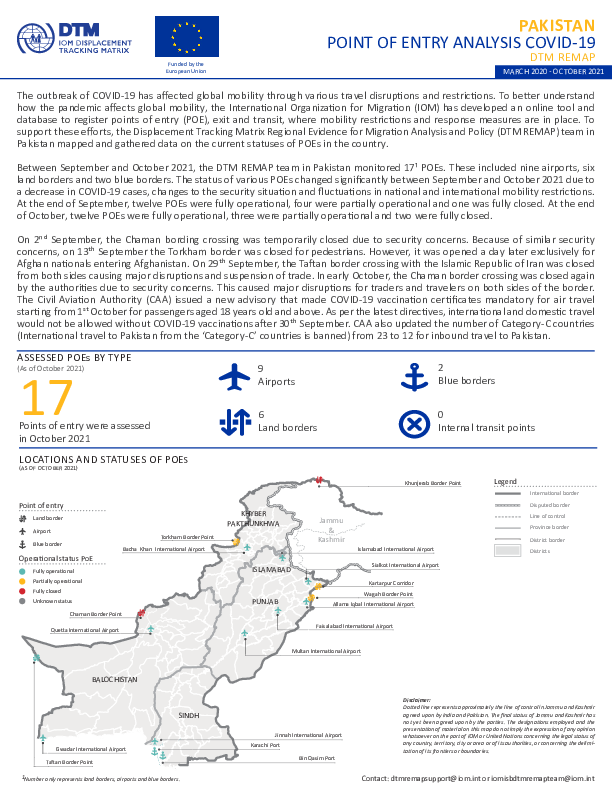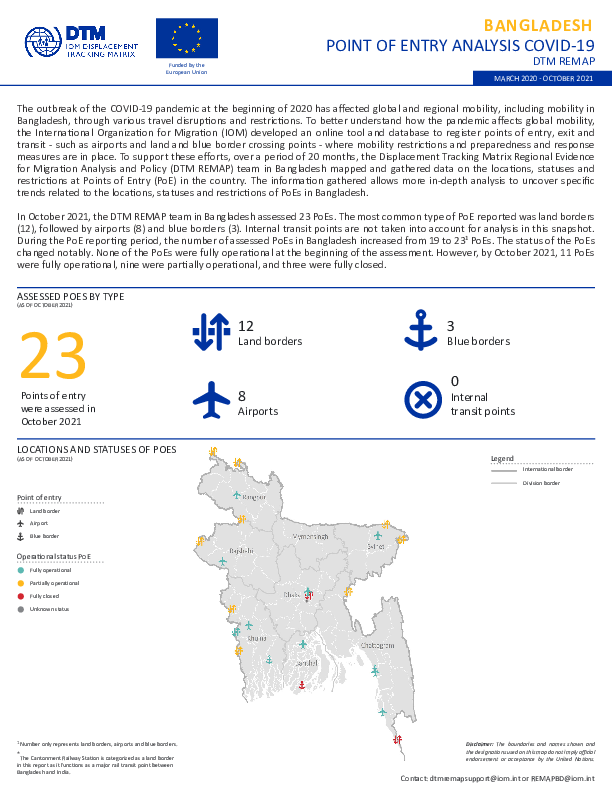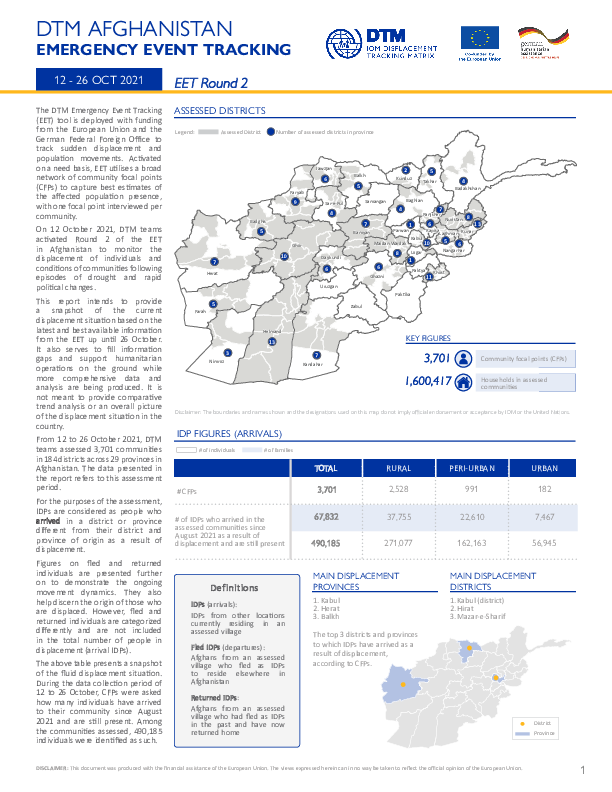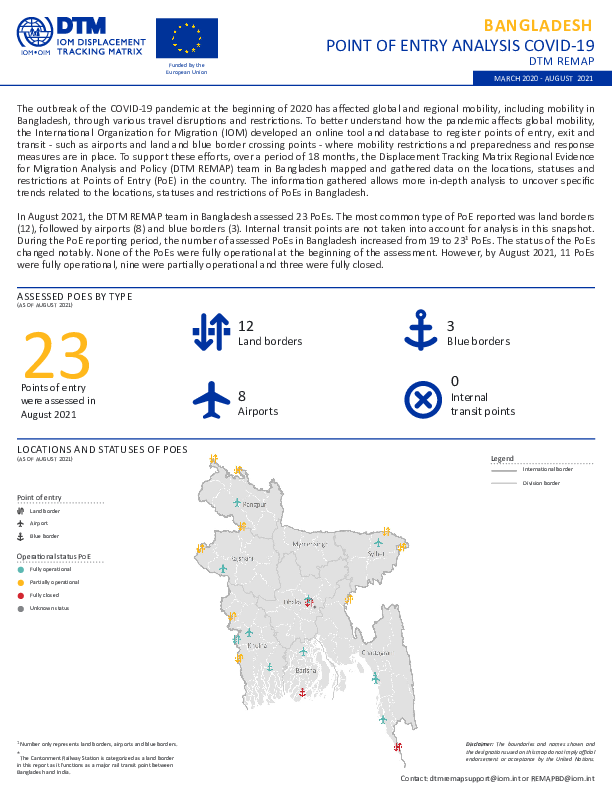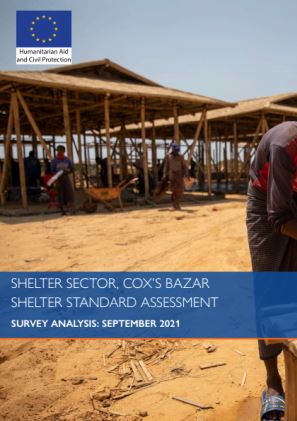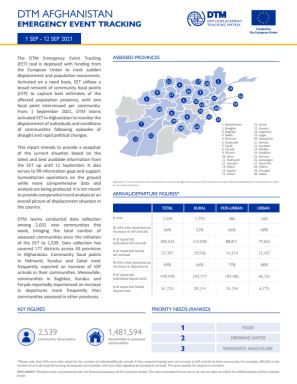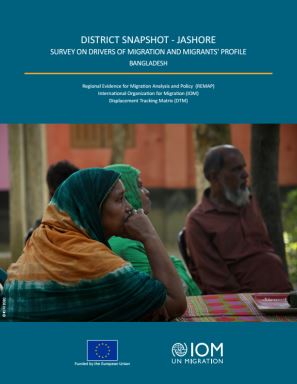-
Countries
-
Data and Analysis
-
Special Focus
-
Crisis Responses
Asia and the Pacific
DTM Asia and the Pacific
DTM Operations in the region
- Active DTM operation
- Past DTM operation
Pakistan – COVID-19 Point of Entry (PoE) Analysis (March 2020 – October 2021)
The outbreak of COVID-19 has affected global mobility through various travel disruptions and restrictions.
Bangladesh – COVID-19 PoE Analysis Dashboard (March 2020 - October 2021)
The outbreak of the COVID-19 pandemic at the beginning of 2020 has affected global and regional mobility, including mobility in Bangladesh, through various travel disruptions and restrictions.
Pakistan - Flow Monitoring of Undocumented Afghan Returnees from Pakistan (July - September 2021)
IOM Pakistan collects data on the outflows of undocumented Afghan migrants at the Torkham and Chaman border crossing points in an effort to better understand the migration movements of undocumented Afghan migrants returning to Afghanistan from Pakistan.
Afghanistan — Emergency Event Tracking (12 - 26 October 2021)
The DTM Emergency Event Tracking (EET) tool is deployed with funding from the European Union and the German Federal Foreign Office to track sudden displacement and population movements.
Pakistan — Flow Monitoring of Undocumented Afghan Returnees from Pakistan (24 October - 06 November 2021)
From 24 September to 06 November 2021, 1,834 undocumented Afghan migrants returned to Afghanistan, including 415 through the Torkham border point and 1,419 through the Chaman border point.
Afghanistan - RLS - Snapshot Report Round 2 ( 23 September - 16 October 2021)
This report intends to provide a snapshot of the second round of RLS data collection that took place between 23 September and 16 October with Afghan migrants who returned from Turkey or the EU between January 2018 and July 2021.
Pakistan - Flow Monitoring of Undocumented Afghan Returnees from Pakistan (26 September - 09 October 2021)
From 26 September to 09 October 2021, 2,115 undocumented Afghan migrants returned to Afghanistan, including 309 through the Torkham border point and 1,806 through the Chaman border point.
Afghanistan — Emergency Event Tracking (1 September - 5 October 2021)
The DTM Emergency Event Tracking (EET) is deployed with funding from the European Union to track sudden displacement and population movements when needed.
Pakistan - Flow Monitoring of Undocumented Afghan Returnees from Pakistan (12 - 25 September 2021)
IOM Pakistan collects data on the outflows of undocumented Afghan migrants at the Torkham and Chaman border crossing points in an effort to better understand the migration movements of undocumented Afghan migrants returning to Afghanistan from Pakistan.
Pakistan - Flow Monitoring of Undocumented Afghan Returnees from Pakistan (29 August - 11 September 2021)
IOM Pakistan collects data on the outflows of undocumented Afghan migrants at the Torkham and Chaman border crossing points in an effort to better understand the migration movements of undocumented Afghan migrants returning to Afghanistan from Pakistan.
Pakistan — COVID-19 Point of Entry (PoE) Analysis (March 2020 – August 2021)
The outbreak of COVID-19 has affected global mobility through various travel disruptions and restrictions.
Afghanistan — Emergency Event Tracking (1 - 27 September 2021)
The DTM Emergency Event Tracking (EET) is deployed with funding from the European Union to track sudden displacement and population movements when needed.
Bangladesh – COVID-19 PoE Analysis Dashboard (March 2020 - August 2021)
The outbreak of the COVID-19 pandemic at the beginning of 2020 has affected global and regional mobility, including mobility in Bangladesh, through various travel disruptions and restrictions.
Afghanistan — Emergency Event Tracking (1 - 20 September 2021)
The DTM Emergency Event Tracking (EET) tool is deployed with funding from the European Union to track sudden displacement and population movements.
Bangladesh — Cox's Bazar Shelter Standard Assessment (January - March 2021)
The goal of the Shelter/NFI Sector is to ensure that every refugee household has access to protection-focused, culturally appropriate Shelter/NFI solutions that provide privacy, security, protection from the elements, reduced exposure to hazards, tenure security, and space to store belongings and
Sep 19 2021
Bangladesh — Cox's Bazar Shelter Standard Ass…
Afghanistan — Emergency Event Tracking (1 - 12 September 2021)
The DTM Emergency Event Tracking (EET) tool is deployed with funding from the European Union to track sudden displacement and population movements.
CBNA R13 — Afghanistan — Community-Based Needs Assessment: Summary Results (April—June 2021)
In April through June 2021, DTM implemented the Community-Based Needs Assessment (CBNA) at the settlement level, as an integral component of DTM's Baseline Mobility Assessment (BMA), providing a comprehensive overview of the evolving, multi-sectoral needs in settlements hosting IDPs and returnees
Afghanistan — Baseline Mobility Assessment Summary Results (April—June 2021)
In Afghanistan, DTM employs the Baseline Mobility Assessment tool, designed to track mobility, determine the population sizes, locations and geographic distribution of forcibly displaced, return and migrant populations, reasons for displacement, places of origin, and times of
ج.ا. ایران - تحلیل گذرگاهها از دید پویایی جمعیتی و کووید19 - مارس 2020 الی ژوئن 2021
March 2020 - June 2021 شیوع همه گیری کووید 19 در ابتدای سال 2020، بر پویایی جمعیتی در سطح جهانی و منطقه ای و همینطور در جمهوری اسلامی ایران تأثیرگذار بوده است که این تأثیر بیشتر به شکل ایجاد محدودیت ها یا تغییرات ناگهانی در مسافرت ها خود را نشان داده است.
Bangladesh – District Snapshot - Jashore - Survey on Drivers of Migration (REMAP 2020)
The Survey on Drivers of Migration (SDM), which was published in July 2020, aims to better understand the drivers of migration in Bangladesh among regular and irregular potential migrants along different thematic areas and themes.
Bangladesh – District Snapshot - Tangail - Survey on Drivers of Migration (REMAP 2020)
The Survey on Drivers of Migration (SDM), which was published in July 2020, aims to better understand the drivers of migration in Bangladesh among regular and irregular potential migrants along different thematic areas and themes.
Bangladesh – District Snapshot - Cumilla - Survey on Drivers of Migration (REMAP 2020)
The Survey on Drivers of Migration (SDM), which was published in July 2020, aims to better understand the drivers of migration in Bangladesh among regular and irregular potential migrants along different thematic areas and themes.
Bangladesh – District Snapshot - Satkhira - Survey on Drivers of Migration (REMAP 2020)
The Survey on Drivers of Migration (SDM), which was published in July 2020, aims to better understand the drivers of migration in Bangladesh among regular and irregular potential migrants along different thematic areas and themes.
Bangladesh – District Snapshot - Chuadanga - Survey on Drivers of Migration (REMAP 2020)
The Survey on Drivers of Migration (SDM), which was published in July 2020, aims to better understand the drivers of migration in Bangladesh among regular and irregular potential migrants along different thematic areas and themes.
Pagination
Pagination
- First page
- Previous page
- 1
- 2
- 3
- 4
- 5
- 6
Pagination
- First page
- Previous page
- 1
- 2
- 3
- 4
- 5
- 6
- 7
